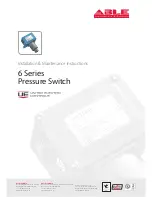
Introduction
1-19
The following conventions apply as you use LCM commands:
¥ Press the
Enter
key to execute a command after you type it in.
¥ A
port range
is either a single port number, or a list of port numbers
separated by commas or hyphens. For example,
3
is port
3
;
3,7
are
ports
3
and
7; 3-5
are ports
3
,
4
, and
5
; and
3-5,7
are ports
3,4,5,
and
7.
¥ To quit any command, press the Control-C keys (^C or Ctrl-C).
¥ You can abbreviate any command where there is no ambiguity; if there
is ambiguity, LCM responds with an error message.
¥ Commands are not case sensitive.
¥ Any invalid commands or misspellings will receive an error message.
¥ A previous command can be repeated by typing
!!
¥ MAC addresses are displayed in little-endian Ethernet (least
signiÞcant bit) bit order, with each octet separated by a colon. For
example:
ELS10-27 >address 00:40:27:04:1a:0f
¥ Information that is optional with an LCM command is enclosed in
square brackets [ ].
ELS10-27 >ipaddr 192.138.217.40
¥ Parameters that appear in all capital letters, for example
bridge [PORT-
RANGE]
, indicate that you must enter a value for that parameter. If a
string of parameters is displayed between braces, for example
[{off|on|noBPDU}]
, you must select one of the displayed options. For
example, if you wanted to enable bridging on a port, or a range of
ports, you would enter:
ELS10-27 >bridge 2-4 on
Summary of Contents for SmartSTACK ETHERNET ELS10-27
Page 2: ......
Page 12: ...Notice x...
Page 16: ...xiv Contents...
Page 74: ...2 14 Unpacking and Installing Your SmartSTACK Ethernet ELS10 27...
Page 94: ...3 20 Configuring Your SmartSTACK Ethernet ELS10 27...
Page 108: ...4 14 Monitoring and Managing Your SmartSTACK Ethernet ELS10 27...
Page 122: ...A 8 EPIM 100FX...
Page 126: ...Index I 4...
















































